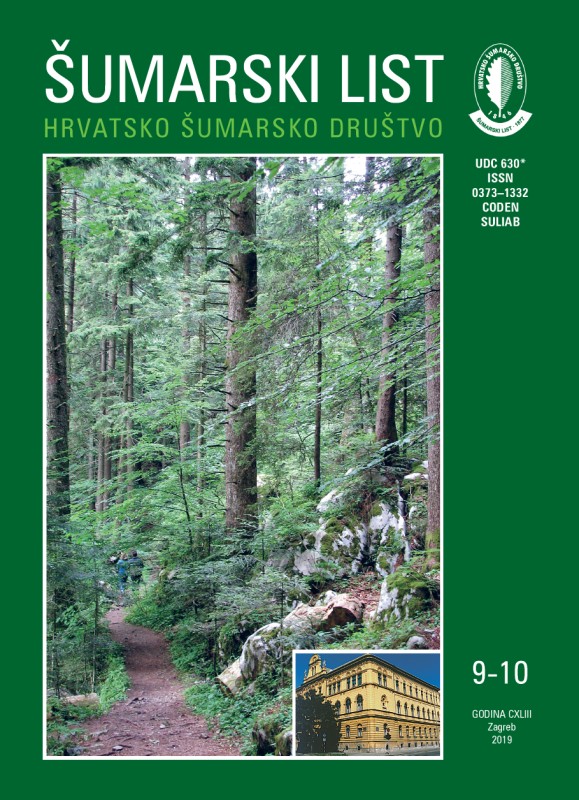
broj: 9-10/2019
pdf (7,03 MB) |
|
||||||||||||||
| RIJEČ UREDNIŠTVA | ||
| Uredništvo | ||
| Will a change in the ministry bring about a changein the attitude towards the forestry profession? pdf HR EN | 389 | |
| IZVORNI ZNANSTVENI ČLANCI | ||
| Damir Ugarković, Željko Španjol, Ivica Tikvić, Dražen Kapučija, Ivana Plišo Vusić | UDK 630* 111 (001) https://doi.org/10.31298/sl.143.9-10.1 | |
| Microclimate differences in the degradation stages of holm oak (Quercus ilex L.) forests pdf HR EN | 391 | |
| Ivan Lukić, Nikola Lacković, Milan Pernek, Christa Schafellner | UDK 630* 453 (001) https://doi.org/10.31298/sl.143.9-10.2 | |
| Redefinition of critical numbers of gypsy moth (Lymantria dispar L.) egg masses for pedunculate oak (Quercus robur L.) and first calculation for common beech (Fagus sylvatica L.) in Republic of Croatia pdf HR EN | 403 | |
| Muammer Şenyurt, Ilker Ercanli | UDK 630* 524 (001) https://doi.org/10.31298/sl.143.9-10.3 | |
| A comparison of artificial neural network models and regression models to predict tree volumes for crimean black pine trees in Cankiri forests pdf HR EN | 413 | |
| Tomislav Sedlar, Tomislav Sinković, Ivana Perić, Andrej Jarc, Srđan Stojnić, Bogoslav Šefc | UDK 630* 812 (001) https://doi.org/10.31298/sl.143.9-10.4 | |
| Hardness of thermally modified beech wood and hornbeam wood pdf HR EN | 425 | |
| PRETHODNO PRIOPĆENJE | ||
| Anamarija Jazbec, Mislav Vedriš, Ksenija Šegotić | UDK 630*945 https://doi.org/10.31298/sl.143.9-10.5 | |
| Analysing the duration of studyng on undergraduate studies et the Faculty of forestry, University of Zagreb pdf HR EN | 435 | |
| Summary Although forestry is often considered as a traditional field of applied science, it resumes its importance in context of increased awareness of climate change and benefits coming from natural ecosystems. Updated and contemporary study programmes are needed to ensure an adequate education on managing forest ecosystems and its products. A better insight in student background and their motivation for studies are welcome to improve the study programmes and also to find the ways how to help students achieve better results. A case study research was carried out to measure success of studies by duration of studies and average grades achieved, with possible causes. Three undergraduate study programmes on Zagreb Faculty of Forestry were analyzed (Forestry N=94, Urban forestry N=54 and Wood Technology N=39), with data acquired from a questionnaire among forestry graduate students on the same faculty academic year 2016/2017. A Factorial ANOVA was performed to test differences between the studies, and a multivariate linear regression for the influence of predictor variables on the duration of study. Although this profession is associated with people from rural areas, about one third of all students comes from the capital city (Figure 1). Students of Wood Technology (DT) are mostly coming from vocational schools (70%) while Forestry (ŠO) and Urban Forestry (UŠ) students are mostly from gymnasiums (67% and 83%). For about 91% of students main motivation was a personal sake rather than a family interest (9%). Average scores and the duration of study on three study programmes have not been proven significantly different between the studies, nor between male and female students (Table 5). A longer time of study is proven to negatively correlated with the average grades on all study programmes: ŠO (r = -0,56), UŠ (r = -0,55) and DT (r = -0,38) (Table 4.). Statistically significant predictor for duration (with logarithmic transformation) on all study programmes in regression analysis was the average grade, with negative sign, thus leading to a shorter study time. Additional statistically significant predictors for ŠO were obtained grant and personal motivation (negative sign), and for DT were sex, obtained grant, and type of high school (Table 6). Key words: academic performance; average grade; duration of study; regression analysis; study programme | ||
| Jelena Nedeljković, Mirjana Stanišić, Dragan Nonić, Mersudin Avdibegović, Marta Curman, Špela Pezdevšek Malovrh | UDK 630* 111 https://doi.org/10.31298/sl.143.9-10.6 | |
| Climate change governance in forestry and nature conservation: institutional framework in selected see countries pdf HR EN | 445 | |
| STRUČNI ČLANCI | ||
| Ivana Plišo Vusić, Irena Šapić, Joso Vukelić | UDK 630* 181.6 + 187 https://doi.org/10.31298/sl.143.9-10.7 | |
| Identification and mapping of Natura 2000 forest habitat types in Croatia (II) – 91F0, riparian mixed forests of Quercus robur, Ulmus laevis, Ulmus minor and Fraxinus angustifolia; 91L0, Oak-hornbeam forests of the illyrian area pdf HR EN | 461 | |
| Damir Drvodelić, Igor Poljak, Ivan Perković, Mario Šango, Katarina Tumpa, Ivana Zegnal, Marilena Idžojtić | UDK 630* 232.3 https://doi.org/10.31298/sl.143.9-10.8 | |
| Laboratory germination testing of the sweet chestnut (Castanea sativa Mill.) according to ISTA rules pdf HR EN | 469 | |


